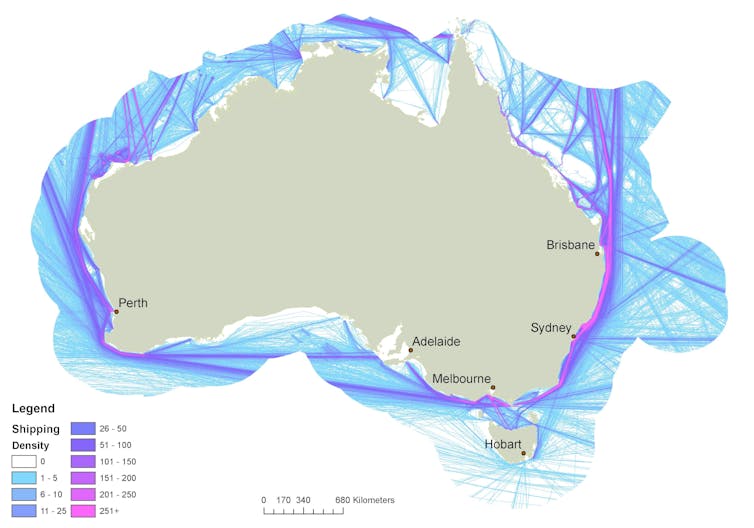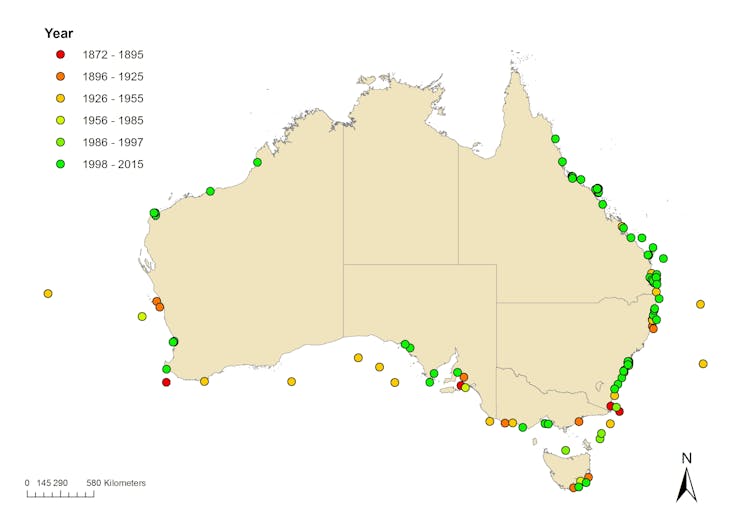November 30, 2016
This article is republished from The Conversation under a Creative Commons license. Read the original article.
David Peel, CSIRO and Joshua Smith, Murdoch University
Living largely on the fringes of a giant island continent, Australians rely on sea transport for the exports and imports that sustain our economy and lifestyle. Australians also have a strong affinity with the ocean, as reflected in the growth in recreational boating and cruise shipping. But these numbers risk putting people on a collision course – literally – with whales, turtles and other marine life.
In the decade to 2011–12, maritime activity in Australia grew by more than two-thirds, while vessels also grew larger and faster. By 2030, bulk freight is projected to increase by half and container throughput will double.
Australia has good shipping regulations, and the general public strongly values marine life. Even so, these drastic increases in both commercial and recreational vessels are likely to lead to more injuries and deaths of marine mammals, large fish and turtles that are hit by vessels – particularly among whale populations that are rebounding in number since the end of whaling.
In response to increasing concern about collision risk, the Department of the Environment and Energy has released a draft national strategy for reducing the risk of vessel strikes. It is open for public comment until January 31, 2017.
The strategy suggests that before we can develop ways to avoid collisions, we need to know exactly where animals are most in danger, by mapping the risk of vessel strike on a national scale. We are working on a project to do just that.

Looking to the past
The first step is to collate and interpret the existing data. Focusing specifically on whales, the current International Whaling Commission (IWC) database shows 51 reported strikes in Australian waters. Only two happened before 1990.
It would be tempting to think that vessel strikes are therefore a modern issue. But the more likely explanation for this pattern is that there has never been a systematic collection of historic Australian data.
We addressed this challenge by searching online media database archives, in particular TROVE. We found reports of vessel strikes dating back to 1872, and an extra 90 records not captured in the IWC’s database. We have thus created the most comprehensive record of whale vessel collisions off Australia.
Our searches brought the number of reported vessel collisions off Australia up to 141. Meanwhile, we also found an extra 145 suspected unrecorded incidents worldwide.
It is hard to compare strike rates around the world because of different record-keeping methods, but our best estimate is that Australian strikes account for 17% of the total worldwide incidents since records began. This challenges the view that these incidents were historically rarer in Australia than elsewhere.
In the records of Australian collisions where the species could be identified, the majority involved humpback whales (52%), followed by southern right whales (12%) and sperm whales (7%). Based on 95 reports in which the fate of the whale could be reliably determined, 52% of strikes were deemed to be fatal or probably fatal; 23% were reported as injuries or probable injuries; and in 25% of cases the whale was unharmed.
Most modern-era strikes are reported in Queensland, which plays host to the east coast humpback breeding and migration route, as well as lots of recreational vessels which are more likely to report incidents as they get damaged. But again, it is very hard to tell how many strikes go unreported, both in Queensland and elsewhere. It may simply be that Queensland has a better system than other states for reporting incidents.

After reading news reports of whale strikes spanning more than 140 years, we were also struck by the changing public and media perception of these events. Early reports from the 1800s refer to ships coming under attack from frightful monsters of the deep. During much of the 20th century collisions were seen as exciting or interesting events during voyages, whereas modern reports are far more concerned with animal welfare and environmental impacts.
You might ask why it matters what happened decades or centuries ago. But of course the past helps us interpret the present.
For example, modern data do not show many large vessels striking animals in Australian waters, whereas these kinds of collisions seem to have been more common in previous eras. This is possibly because, historically, most large vessels had large crews and/or many passengers, potentially making collisions more likely to be spotted than they would be aboard today’s large automated vessels with small crews. This raises the question of whether significant numbers of collisions are happening without being noticed.
Recording vessel sizes will also help to devise the most effective strategies for avoiding collisions. For example, if small recreational vessels pose the most significant strike threat in a given region, then changing the region’s commercial shipping lanes will be of little use.
What can be done?
The jump in the number of reported vessel strikes in the late 1990s suggests that reporting rates have probably improved, but also highlights the need for a much more rigorous system. With this aim, the Australian Marine Mammal Centre has developed an online tool for reporting collisions.
The next task for our project is to compare information on shipping density and average speeds with data about the habitats and migration routes of at-risk species. This will help us draw up relative risk maps to identify specific areas and times where the risk is greatest, and where efforts to reduce them should be focused.
Some measures, including route changes, speed restrictions and exclusion zones, have already been successfully used in waters off the United States and New Zealand.
With Australia’s increasing appetite for international trade and recreational boating, it is time to develop some effective methods of our own to avoid running over our marine wildlife.
This article was co-authored by Dr Simon Childerhouse, a marine mammal biologist with Blue Planet Marine based in Nelson, New Zealand.![]()
David Peel, Statistician, Data61, CSIRO and Joshua Smith, Postdoctoral Researcher, Murdoch University
- Log in to post comments
